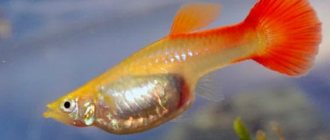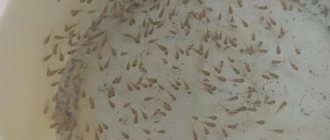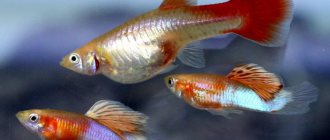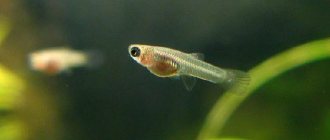What do guppies eat in the wild?
In warm freshwater or brackish waters of Guyana, Brazil, Venezuela, where guppies come from, they feed on the larvae and eggs of mosquitoes and mosquitoes. The smallest representatives of river fauna are used as food: crustaceans, ciliates, and fry of other fish species. Guppies eat various algae, so in aquarium conditions the diet should consist of both protein live food and plant components.
Wild guppies in their natural habitat.
Small, unpretentious fish will forgive the owner for minor changes in the environment, lack of sophistication in the aquarium and errors in maintenance. The only condition for comfortable cohabitation will be proper fractional nutrition, alternating the necessary components. It is not difficult to diversify the guppies' menu - they are ready to eat any type of food: live and specialized, from the store. Growth, brightness of color, and reproductive function depend on the diet . Beginner aquarists should know what to feed guppies and what food is preferable for them.
Habitat
Historically, guppies live in Central, northern South America and the Caribbean islands. These are countries such as Brazil, Venezuela, Guiana, Trinidad and Tobago. Thanks to their amazing endurance, the fish have inhabited almost all possible freshwater biotopes: rivers, lakes, canals, swamps. Some populations can be found even at the mouths of rivers flowing into the ocean, where mixing of fresh and salt water occurs.
They prefer warm rivers with gentle currents. The fish live in small schools (up to 10 pieces) in dense thickets of plants, where they hide in case of danger. They usually swim near the surface of the water.
Currently, guppies are a true cosmopolitan species. Thanks to artificial acclimatization to combat the larvae of the malaria mosquito, the fish can be found on all continents. The widespread use of fish as an aquarium pet also played an important role.
Guppies are one of the hardiest fish, capable of living in a wide range of water parameters and surviving, sometimes, in extremely extreme conditions. It is reliably known that wild populations (probably released by aquarists) have adapted to live even in the rivers of large cities, in places where warm wastewater is discharged.
Essential microelements
The need for vitamins depends on age, weight, growth rate, health status, and level of productivity. For normal growth, development, and healthy offspring, guppies must receive food that maintains a balance of vitamins and microelements. The food must contain:
- Water-soluble B vitamins and vitamin C, which activate metabolism and the activity of enzyme systems.
- Fat-soluble A, D, E, K, affecting protein, fat and mineral metabolism.
- Vitamins E and C, antioxidants.
- Calcium, which ensures bone strength, participates in the processes of muscle contraction and blood clotting.
- Phosphorus for complete digestion of food. Regulates hormonal levels, takes part in the transmission of hereditary information. The need for phosphorus is observed in young guppies at the stage of skeletal ossification.
- Magnesium, responsible for the neuromuscular system of fish. It is involved in osmoregulation and the breakdown of nucleic acids.
- Cobalt – healthy immunity.
- Iodine is an integral part of thyroid hormones.
- Manganese, which protects the liver from fatty degeneration, is involved in tissue respiration and reproductive function.
- Iron for respiration and oxidative processes.
- Cobalt, which prevents anemia, affects the exchange of nitrogen in nucleic acids.
Selenium deficiency is the cause of pathologies in the cells of the spinal cord and liver, which leads to the death of fish. Zinc deficiency affects hematopoiesis, vision, reproduction, development and growth.
Males have bright fins and to maintain color they are given carotenoids and special additives 2-3 times a week.
Required Power Components
A lack of calcium (Ca) in the diet and water can be critical. Leads to disturbances in the development of the skeleton, fins, and scales (rickets).
Squirrels
Protein (protein) is a set of amino acids. Serves to produce energy and form body tissues. In the diet - 25–35%. For fry and pregnant females - 40–50%. Source: animal food. Vegetable proteins are almost not digestible by fish.
Fats
Fats - saturated and unsaturated fatty acids, their compounds. Unsaturated fats are not produced in the body of fish. “Spare” source of energy, the main material for metabolism. In the diet of aquarium fish - 4–8%. Lack of fat in food weakens the immune system and causes disruption of the central nervous system. Source: animal food.
Carbohydrates
Carbohydrates (sugars) are compounds made of oxygen, carbon and hydrogen. A source of “fast” energy. In the diet - up to 20%, up to 6 mg per gram of fish weight. Higher sugars are partially absorbed by omnivorous fish. Fiber (cellulose) is not digestible, but is necessary for the movement of food masses through the intestinal tract. A lack of sugars leads to gastrointestinal diseases, the formation of ulcers, and weakened immunity.
Micro- and macroelements
The presence of macroelements (content in the body from 2 mg/kg) and microelements (up to 2 mg/kg) is ensured by maintaining the required level of water hardness and proper nutrition.
Vitamins
Vitamins are a group of compounds that ensure metabolism in the body. Lack of vitamins (avitaminosis) is externally manifested in abnormal behavior, stunted growth and dull coloring. Vitamin deficiency causes irreparable damage to the fry.
| Name | What is he responsible for? | Symptoms and consequences of vitamin deficiency |
| B | Obtaining energy from carbon compounds. Nutrition of the central nervous system. | Decreased activity. Convulsions. Lack of appetite. Stopping growth. |
| B2 | Protein absorption. Nutrition of the central nervous system | Internal bleeding. Central nervous system disorder with motor dysfunction |
| B5 (PP) | Enzyme synthesis | Terminal deformation |
| B6 | Functioning of the nervous system | Motor function disorder |
| B12 | Function of the digestive system. Hemoglobin synthesis | Anemia. Decreased activity. Stopping growth |
| A | Vision. Height. Protection of the mucous membrane. Sexual function | External changes in the eyes, bulging eyes. Stopping growth. Internal bleeding |
| C | Growth and restoration of the skeleton. Immunity | Deformation of terminals. Lack of disease resistance |
| D3 | Absorption of calcium and phosphorus | Skeletal deformity, rickets |
| E | Digestion and synthesis of fats | Fatty liver. sterility |
| H | Tissue development | Stopping growth. Lack of appetite. Convulsions |
| K | Blood composition | Wounds don't heal. Liver damage |
| Kholin | Fat processing | Fatty liver. General obesity |
Dry food: which one to choose
The variety of offers makes the guppy's diet rich and not boring. The assortment includes dust, flakes, granules, tablets. There are single-ingredient feeds, and there are complex ones, with vitamin supplements, of plant and animal origin. Manufacturers made sure that the guppy was not only well-fed, but also had the appropriate color, activity, and fertility. Among the popular brands:
Tetra
A German company that sells a variety of feed and other related products for all types of fish. The advantage is a wide selection and affordable price. Flakes, tablets of plant and animal origin, as well as fish treats from Tetra undergo mandatory certification .
Hikari
The brand belongs to a Japanese manufacturer that supports the health of fish with high-quality food. The company's laboratories are working on formulas that are used in accordance with the age, needs and developmental characteristics of fish. Dry vegetable chips, sinking tablets, frozen larvae, mineral supplements do not cause damage to aquarium water and maintain the tone of the fish.
Aquarian
American manufacturer supplying tested quality fish food. The only drawback is that there are no representative offices in Russia, but this does not stop aquarists: they find the company’s distributors or place orders via the Internet.
Sera
German brand food is distinguished by its low price and variety. It is not a problem to buy food in a 10-gram bag and in a 10-kilogram bucket. The assortment includes flakes, granules, etc.
Aller Aqua
Manufacturer from Poland. The peculiarity of the feed is its versatility - it is suitable for a mixed community. The assortment for aquarium fish is small but comprehensive: it consists of plant and animal components.
JBL
Manufacturer: Germany. Offers a wide range of feeds, in a variety of packaging and forms. The price of the products is affordable, the selection of related accessories is large. Judging by the reviews, aquarists would like to have a larger selection of animal foods.
Tropikal
A company from Poland sells food with a high protein content. This improves the nutritional value of the food and helps maintain the health of aquarium inhabitants.
As for the form of food release, guppies easily collect flakes: thin and thick, “chips”, extrudates. Granular food is not always suitable for them - the fish’s mouth is small and it will not be able to grab a large granule. Food in the form of dust is well eaten by fry. Many of the listed companies produce dried plankton, either species or in mixtures. Starting compositions are also available in the form of microgranules.
Tablet pressed food is used for feeding after fasting days - in order to get enough, guppies must make an effort.
History of appearance/discovery
One of the first scientists to describe guppies was the famous German zoologist Wilhelm Karl Hartwig Peters in 1859. He gave the fish the name Poecilia reticulate, which existed until 1861, when the Italian researcher F. de Filippi studied the obtained alcoholized materials and identified a separate genus Lebistes, and the fish was named Lebistes poeciloides.
The fish received its second name “guppy” (in the original “guppy”) in honor of the English scientist and priest Robert Guppy (R. Guppy), who brought it to England from the island of Trinidad in 1866. The fish survived the month-long journey well and were presented by Robert to the scientific board of the British Museum of Natural History. He assigned them to the new genus Girardinus, and named the fish after himself - Girardinus guppyi.
When it turned out that seven years earlier the fish had already been described by another scientist, it was renamed again, this time to Lebistes reticulatus. And only in 1963, after an extensive revision of viviparous fish from the Petsiliev family, carried out by ichthyologists D.E. Rosen and R.M. Bailey, the guppy has been reverted to its original name, Poecilia reticulate Peters. Nevertheless, the name “guppy” is very firmly attached to the fish, both in English-speaking countries and in Russia.
In the modern world, natural guppies are no longer caught in the wild. Numerous hybrids obtained on special fish farms are sold in millions of quantities all over the world.
Standards for guppy breeds have been created at the world and national levels. In almost all countries there are huge amateur clubs that participate in regular exhibitions of these beautiful fish.
DIY guppy food
You can diversify your fish’s diet at home by using available products from the grocery store. You can give slightly overcooked semolina, Hercules, biscuits. Earthworms are available as live food. The treat can be frozen in small portions and given to fish in winter.
On fasting days, the guppy menu consists of plant foods. They give nettle leaves, spinach, and seaweed scalded with boiling water. In addition, at this time guppies willingly collect algae deposits from plants and stones.
08:36
Food for guppies and more... MEGA vegetable, vitamin omelette for aquarium fish!
17:48
DIY fish food. We improve coloring and immunity.
25:21
preparing food for guppy
A hard-boiled egg yolk is a good source of protein for fry, as long as it is prepared correctly. Before feeding, the yolk is ground in a glass of boiled water, washed with repeated settling until the water poured into the glass becomes clear. Washed yellow microgranules are given to the fish. They stay suspended in the water and are happily eaten by fry.
You can prepare vitamin cocktails for the winter:
- Grind thawed mussels, cyclops, daphnia, banana, boiled carrots twice in a meat grinder, and pack them into portions.
- Greens (nettle leaves, spinach, dandelion), mussel meat, medium-ripe banana, half-cooked pumpkin or carrots, paprika.
Products for cooking are taken in approximately equal quantities. This is an ideal vitamin and protein food for gourmet guppies - varied, healthy, satisfying.
Live food: pros and cons
Natural food occupies the most important place in the nutrition of fish. It contains chemical elements in a consistent ratio and compensates for the deficiencies of mixed feed. In winter, they give frozen food from bloodworms and cyclops. Guppies happily eat chopped squid fillets or river fish. The food also includes chicken breast, shrimp, beef liver and heart, pea hulls, and earthworms.
Gamarus and daphnia mixed with trivitamin (3 drops per 5 g of food) or with a few drops of fish oil are used as a supplement.
Despite the high nutritional value and good acceptability by fish, live food has a number of disadvantages:
- they are difficult to obtain on your own;
- It is impossible to check the quality of purchased ones;
- tubifex worms contain a large number of harmful bacteria;
- Daphnia consume a lot of oxygen, which negatively affects the condition of the aquarium as a whole;
- many are carriers of pathogenic microflora.
Pet store employees actively offer tubifex worms and live daphnia as suitable food for guppies, but many aquarists have abandoned these products.
If you use daphnia, then in portions, measuring 5-15 individuals per adult guppy. They do it this way: take 1 ml of culture into a syringe, calculate the number of daphnia in 1 ml. Next, feed is added into the aquarium depending on the number of fish. The tubifex is fed no more than 1-2 times a week. The norm is 1-3 pieces per guppy.
Diseases
Guppy diseases can be caused by poor care and infection from contaminated food, plants or other fish. The most common ailments in guppies are problems with their fins:
- Fin compression. Appears due to monotonous and poor nutrition during growing up. Treat with salt baths (1 g of salt per 1 liter of water).
- Fin separation. Most often, the caudal fin splits into several parts. Occurs due to fighting or lack of vitamin D. To treat, add 0.1 ml of iodine to the aquarium for every liter of water.
- Fin rot. Appears due to improper maintenance and infection. Ulcers form on the edges of the fins, which quickly grow over the entire surface. During the process of rotting, the fins disintegrate. Treatment should be with 20-minute salt baths (3 teaspoons of salt per 5 liters of water) and streptocide solution (1.5 mg of medication per 10 liters of water). Also be sure to disinfect the aquarium and rinse the plants and soil. Treatment is continued until the disease subsides.
- Red scab. A scarlet coating appears on the edges of the fins. The disease is caused by the parasite Tetrahymena. Remove infected guppies from the general population. To cure the fish, use a blade to remove the affected areas of the fins and use a solution of chloramphenicol (1 tablet per 20 liters of water). Salt baths also help well. Continue treatment until the fish is completely cured.
Guppies are an excellent choice for beginner aquarists; they are unpretentious, easy to breed and delight with their activity and cheerfulness. Experienced lovers of aquarium inhabitants will enjoy representatives of rare selected species and colors of guppies. They are more demanding to care for, but also incomparably more beautiful.
How often should you feed your guppies?
It is important not to overfeed or starve your fish. The frequency of feeding depends on age: adults receive food 1-2 times a day . The fry require 6 meals a day during the first month of life; in the second and third months they eat 3-4 times a day. For the next 2 months, the fish receive food like adults - 2 times a day, and are gradually transferred to an adult diet.
The feeding regime is set depending on the capabilities of the owner of the aquarium: if it is working, then the fish receive food in the morning and in the evening, such feeding becomes habitual for them. It is possible to feed the guppies during the lunch break - good, the main thing is that the portions are small and the menu varied.
Serving Size
You need to feed in small portions. The time of eating food is determined experimentally. Cheerful, healthy guppies pick up food in a minute or a minute and a half. The amount of food added at a time depends on the population of the aquarium. For a small number of guppies, add a small pinch of food so that it is eaten within 1-2 minutes.
Content
- 1 Description
- 2 Conditions of detention
- 3 Food
- 4 Behavior
- 5 Reproduction
- 6 Guppy fry
- 7 Other types
Guppy
- Other names: Poecilia reticulata, Guppy.
- Origin: Trinidad and Northern Venezuela.
- Size: 5 cm.
- Temperature: 18-28 °C.
- Behavior: peaceful, gregarious.
- Growth rate: average.
- Content difficulty: low.
Guppy
(
Poecilia reticulata
) is a freshwater viviparous fish, about 5 cm, gray in color with a greenish-olive tint, with transparent, colorless fins of a small round shape. Life expectancy is 3-4 years. The most popular and unpretentious aquarium fish. This viviparous fish is beautifully colored, easy to care for, and can be kept and bred even in a three-liter jar at room temperature. Due to the undemanding nature of guppies in terms of keeping conditions and the wide variety of shapes and colors, scientists use this fish for research on genetics, ethology, embryology, physiology, etc. Guppies have been bred in aquariums since the beginning of the last century. Breeders have obtained many varieties of this fish
How to avoid overeating
A small fish has a very small stomach, so overeating is deadly . How to visually determine excess feed:
- Adults are noticeably rounded in parts of the abdomen and thorax.
- The water becomes cloudy, although the replacement regime is followed.
- A dark thread of excrement trails behind the fish - the intestines are clogged, which threatens to rupture.
In this case, reduce the portions, the frequency of feeding, and monitor the size of the food. You need to temporarily remove high-calorie foods from your diet, replacing them with finely chopped beef heart. It is useful to give the fish a “hungry” day.
Guppies easily endure a week-long hunger strike in the absence of the owner. There is no need to ask your neighbors to feed them: accidental overfeeding leads to water spoilage and subsequent death of the fish.
How to feed the fry
Newly born guppies are separated from adult fish. Young animals need special dust-like nutritious food available in the store, suitable for their size. They eat small brine shrimp, bloodworms, finely ground beef heart, and egg yolk mixed with water. The fry have a tiny stomach, so they are fed 6-7 times a day.
Before 2 weeks of age, babies are not given fasting days. From days 15 to 45, on the fasting day, young people eat spirulina.
Common mistakes
Guppies are picky and omnivorous. But still, beginning aquarists often fail to achieve the desired activity and color saturation of the fish. What could be the reason:
- Constant feeding with dry food makes the fish colorless: the tail loses the appearance of a veil, and the functioning of the gastrointestinal tract is disrupted.
- Feeding adult males and females the same dry food leads to infertility.
- Insufficient grinding of food leads to swallowing large pieces and rupture of the intestines.
- Residues of food remain in the aquarium: they decompose, forming nitrogenous compounds harmful to fish.
When keeping guppies, it is recommended to stick to the basics: feed them with high-quality food purchased from trusted suppliers and avoid overeating. Undemanding aquarium inhabitants will be active and healthy if a balance is maintained between live food, dry mixtures, plant components and vitamin supplements. Finding food that satisfies the physical needs of guppies today is not difficult, nor is it difficult to prepare it yourself. It is only important to choose food that is suitable for a specific situation among the pet store offers.
Reproduction
Guppy is a viviparous fish. It reproduces easily in an aquarium without special preparations. However, if you want to breed quality guppies, selective breeding is necessary.
Choose a pair of guppies whose color, size and fin shape you like. Males can be identified by their brighter colors, are smaller than females, and have a small, thin anal fin used for fertilization called the gonopodium.
The female carries the fry for approximately 21-27 days. Closer to childbirth, the belly becomes slightly rectangular in profile, with corners prominent in front and behind. Form is assessed before feeding. The female also begins to behave restlessly, swim up and down, and generally unusual. Sometimes he refuses to eat. Just before giving birth, he tries to hide somewhere.
After they have reproduced, select and remove the male and female or several females that you like best, and so on.











